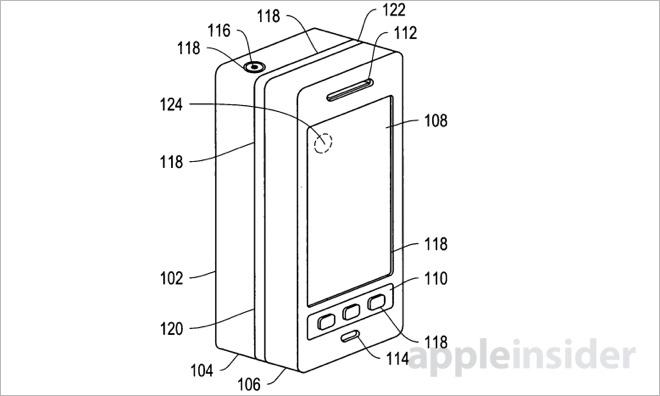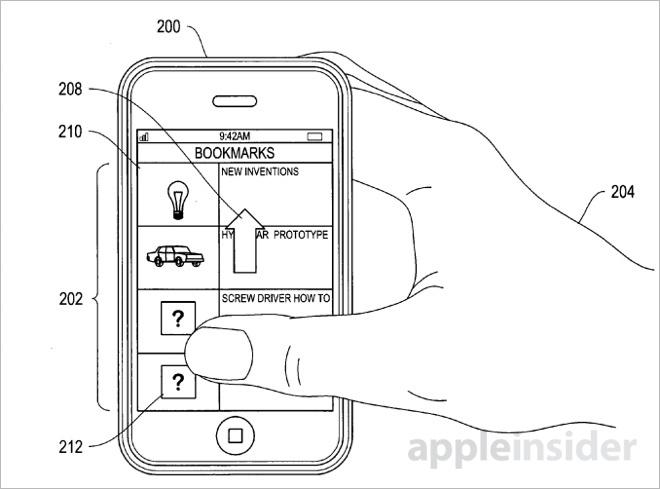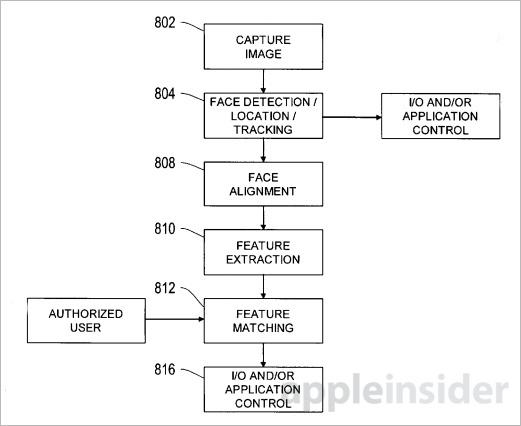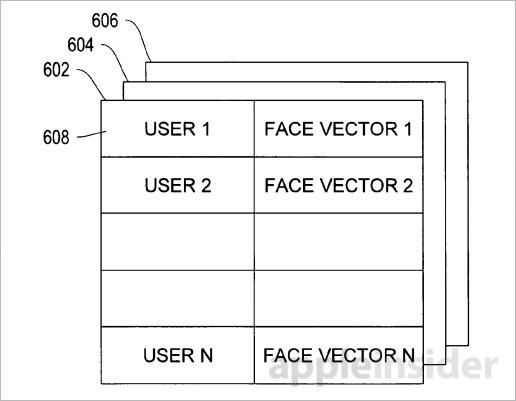Apple on Tuesday was granted a patent that uses facial recognition technology to control a computing device, like an iPhone, iPad or Mac, allowing for a more secure and productive operating environment.
The U.S. Patent and Trademark Office awarded Apple U.S. Patent No. 8,600,120 for "Personal computing device control using face detection and recognition," a property that looks to beef up device security as well as make the computing experience more convenient for users.
As noted in the document, face detection and recognition are two different processes. Detection involves locating faces within an image, while recognition goes deeper by pairing those faces with a particular person or user. Typically, facial recognition follows detection.
Apple's patent comprises three separate systems: a face detection decision application; a face recognition application; and an input/output control application. These systems work together to detect whether a user is authorized to operate a given device, and if so, activate certain functions within the computing environment.
In practice, the detection application can scan a defined area where a user is expected to appear, using knowledge-based, feature-based or template matching techniques to identify faces. A number of features are taken into consideration with the matching techniques, including relationships of facial features, identification of facial structures like skin tone, shape, and skin texture, and encoded learning models.
As for facial recognition, at least one embodiment compares face feature vector data, gathered from an image output by an on-board camera, with stored vector data. These vectors can range from face shapes to distance between facial features, such as eyes and nose.
Using the vector data, the system determines whether a user is authorized to operate the device and controls data input/output based on this information.
For example, during an incoming phone call, an iPhone may be able to "sense" that someone is looking at the device's screen. If the person is not an authorized user, the iPhone's screen remains off and only a ringtone or vibration alert is provided. If the person is an authorized user, the usual incoming call UI is displayed.
In another example, an incoming email can be blocked from view unless the authorized user's face is detected by the system. This implementation would be helpful for users who choose to display part of the message in the lock screen.
The document describes another use scenario in which a user can be monitored while positioned in front of a computer. As long as the user's face is recognized over a set period of time, the system can activate or inhibit various device functions like screen savers, video settings, audio settings and communications settings, among others.
The patent goes on to describe in detail the facial recognition application, including a unique algorithm that uses face pattern recognition to "learn" a user's face.
It is unknown if or when Apple plans to implement the technology into its computers or mobile devices, but facial recognition is quickly gaining momentum in the consumer electronics industry. The new Xbox One and PlayStation 4 gaming consoles tout the feature for user logins, while rival smartphone makers have toyed with the tech to varying degrees of success.
Most recently, Apple purchased PrimeSense, an Israeli motion-sensing hardware and software firm responsible for the technology behind Microsoft's first Kinect sensor. While the system described in Tuesday's patent is primitive compared to PrimeSense's applications, the property could be a small part of a larger initiative focusing on novel forms of user input.
Apple's face recognition patent was first filed for in 2008 and credits Jeff Gonion and Duncan Robert Kerr as its inventors.
 Mikey Campbell
Mikey Campbell










-m.jpg)






 Marko Zivkovic
Marko Zivkovic
 Mike Wuerthele
Mike Wuerthele
 Christine McKee
Christine McKee
 Amber Neely
Amber Neely
 Sponsored Content
Sponsored Content
 Wesley Hilliard
Wesley Hilliard

 William Gallagher
William Gallagher









16 Comments
Ok, let's hear the trolls. ------------------------------ On a serious note. Here is where Apple triumphs: implementation. I'm sure it'll be awesome once Apple gets it together. I'm sure it'll be better than the half-cooked version of face recognition I have tried in other devices. It is so lame that you can unlock a device just by using another phone to show the device a picture of the user to unlock it. I'm really curious to see if or how Apple would address that huge issue. Because believe me, if all someone needs to bypass this feature is a picture of you, well...
[quote name="eckergus" url="/t/161009/future-iphones-may-unlock-hide-messages-based-on-a-users-face#post_2442411"]Ok, let's hear the trolls. ------------------------------ On a serious note. Here is where Apple triumphs: implementation. I'm sure it'll be awesome once Apple gets it together. I'm sure it'll be better than the half-cooked version of face recognition I have tried in other devices. It is so lame that you can unlock a device just by using another phone to show the device a picture of the user to unlock it. I'm really curious to see if or how Apple would address that huge issue. Because believe me, if all someone needs to bypass this feature is a picture of you, well...[/quote] This is where PrimeSense's spacial mapping comes into play... A photo of a face would appear as a flat surface and wouldn't count as a real face.
Hmm,,,,this patent was first filed in 2008. Why did it take so long to get approved?
Ok, let's hear the trolls.
On a serious note. Here is where Apple triumphs: implementation. I'm sure it'll be awesome once Apple gets it together. I'm sure it'll be better than the half-cooked version of face recognition I have tried in other devices. It is so lame that you can unlock a device just by using another phone to show the device a picture of the user to unlock it. I'm really curious to see if or how Apple would address that huge issue. Because believe me, if all someone needs to bypass this feature is a picture of you, well...
They will likely address that issue the same way it was already (quickly) addressed in Android. Face unlock requires the user to blink.
[quote name="eckergus" url="/t/161009/future-iphones-may-unlock-hide-messages-based-on-a-users-face#post_2442411"]Ok, let's hear the trolls. ------------------------------ On a serious note. Here is where Apple triumphs: implementation. I'm sure it'll be awesome once Apple gets it together. I'm sure it'll be better than the half-cooked version of face recognition I have tried in other devices. It is so lame that you can unlock a device just by using another phone to show the device a picture of the user to unlock it. I'm really curious to see if or how Apple would address that huge issue. Because believe me, if all someone needs to bypass this feature is a picture of you, well...[/quote] Detecting 2D from 3D is probably not too hard, identical evil twin on the other hand .....